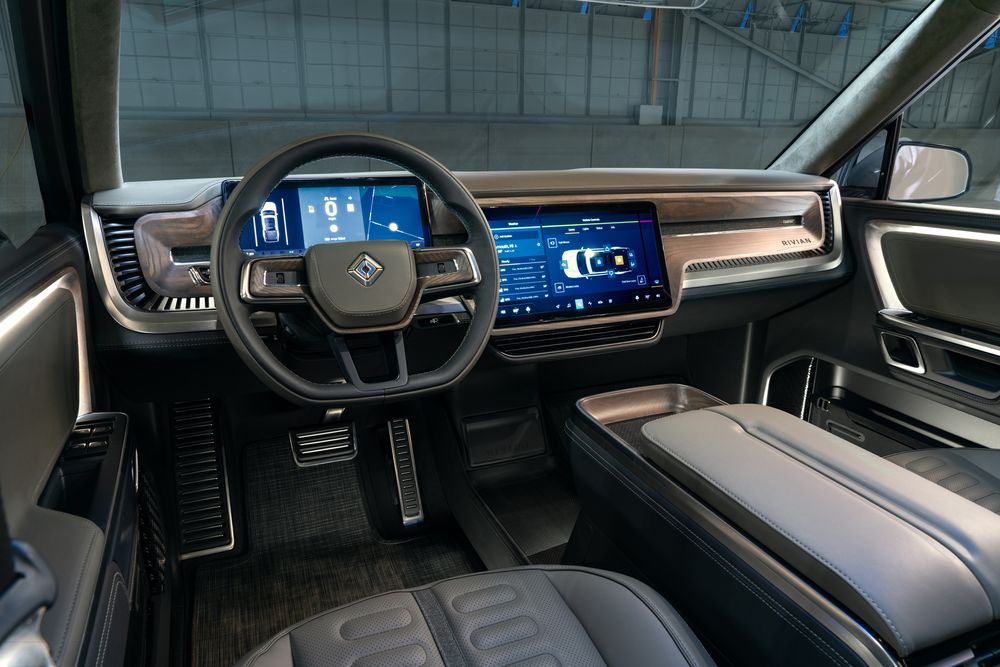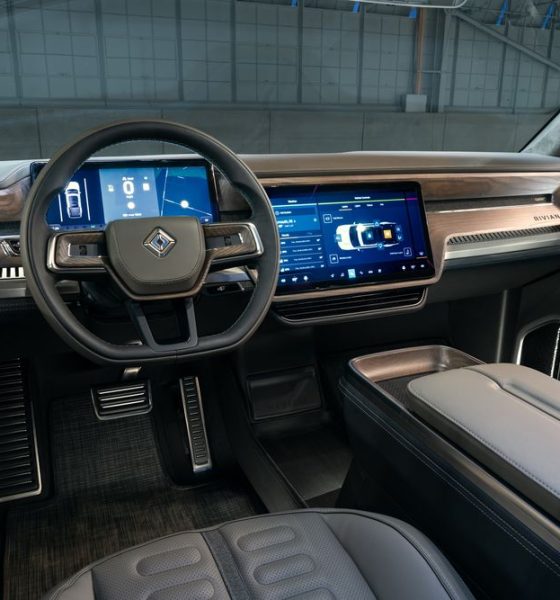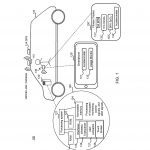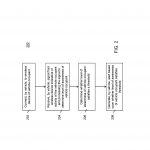

News
Rivian’s self-driving patent application hints at driver monitoring functionality
Rivian’s Associate Director of Self-Driving, Oliver Jeromin, discussed a driver monitoring system that’s part of the company’s full self-driving suite in a recent interview. Thanks to a recently published patent application by the all-electric carmaker, more details about how such a system would work are now available.
The patent application, titled “Occupant Awareness Monitoring for Autonomous Vehicles,” was published on July 25, 2019, under serial number US 2019/0225228. It describes a multi-part system wherein driver activity is interpreted through synced wireless devices either on a smartphone or directly with the vehicle itself. If a driver’s awareness is needed and determined not to be available, the vehicle will take remedial action to ensure a high level of safety.
The five levels of vehicle autonomy defined by the Society for Automotive Engineers (SAE) (and adopted by the U.S. National Highway Traffic Safety Administration) range from level 0 with no automation to level 5 with full automation. Levels 3-5 specifically require that their human driver (or passenger if Level 5) be ready to retake control of the vehicle or respond in some way under specific circumstances. That said, Rivian’s invention described in this application seeks to detect whether the necessary level of readiness is present in the driver.
- Rivian’s driver monitoring patent application. | Image: Rivian/USPTO
- Rivian’s driver monitoring patent application. | Image: Rivian/USPTO
“The present inventors have recognized the technological problem of a potential need for human intervention in connection with the operation of autonomous automotive vehicles featuring autonomy levels 3, 4, or 5, and have observed a need for a technological solution to monitor the awareness of vehicle occupants,” the application states in the background portion of the description.
The monitoring process is described to work as follows:
- Connect, by vehicle, to wireless device of vehicle occupant.
- Receive, by vehicle, signal from wireless device indicative of activity of the vehicle occupant and processing the signal to determine level of awareness of vehicle occupant.
- Determine whether level of awareness of vehicle occupant satisfies a threshold.
- Generate, by vehicle, alert based upon whether level of awareness of vehicle occupant satisfies threshold.
To accomplish these steps, Rivian proposes in the application to pair electronic devices that can track and provide driver data to the automated driving program, e.g., general smartphones or tablets, finesses trackers, and electronically connected medical devices. If a driver is watching a movie or has vital signs indicating sleep (breathing rate, pulse, etc.), the vehicle would know the driver is not ready to resume control if needed and respond appropriately.
Also described in the patent application are enforcement ideas such as a series of touch screen prompts requiring a response, and in the event of no response, the vehicle would pull over and stop. If an emergency situation were detected via the connected medical devices, the car would pull over and call 911. Along with a fitness tracker, other medical devices suggested for use in the application are glucose monitors, blood oxygen monitors, and breathalyzers.
Driver attentiveness while using self-driving features is already a problem under Level 2 programs where warning prompts are fairly strict about keeping eyes on the road. Tesla, for instance, regularly reminds its customers that Autopilot isn’t a full self-driving system yet and needs complete driver attention. However, as headlines and Tesla crash investigations have indicated, the warning isn’t always heeded.
Rivian’s driver monitoring system certainly sounds like a good step towards increasing safety measures as the carmaker continues to develop its product lines. The proposed syncing of medical devices might run into some resistance on privacy grounds, but the overall payoff that a safe self-driving experience will provide may find cause for compromise. Overall, it’s clear Rivian has safety as a priority as it prepares to enter the automotive arena with the R1T pickup truck and R1S SUV later next year.

News
Nvidia CEO Jensen Huang explains difference between Tesla FSD and Alpamayo
“Tesla’s FSD stack is completely world-class,” the Nvidia CEO said.

NVIDIA CEO Jensen Huang has offered high praise for Tesla’s Full Self-Driving (FSD) system during a Q&A at CES 2026, calling it “world-class” and “state-of-the-art” in design, training, and performance.
More importantly, he also shared some insights about the key differences between FSD and Nvidia’s recently announced Alpamayo system.
Jensen Huang’s praise for Tesla FSD
Nvidia made headlines at CES following its announcement of Alpamayo, which uses artificial intelligence to accelerate the development of autonomous driving solutions. Due to its focus on AI, many started speculating that Alpamayo would be a direct rival to FSD. This was somewhat addressed by Elon Musk, who predicted that “they will find that it’s easy to get to 99% and then super hard to solve the long tail of the distribution.”
During his Q&A, Nvidia CEO Jensen Huang was asked about the difference between FSD and Alpamayo. His response was extensive:
“Tesla’s FSD stack is completely world-class. They’ve been working on it for quite some time. It’s world-class not only in the number of miles it’s accumulated, but in the way it’s designed, the way they do training, data collection, curation, synthetic data generation, and all of their simulation technologies.
“Of course, the latest generation is end-to-end Full Self-Driving—meaning it’s one large model trained end to end. And so… Elon’s AD system is, in every way, 100% state-of-the-art. I’m really quite impressed by the technology. I have it, and I drive it in our house, and it works incredibly well,” the Nvidia CEO said.
Nvidia’s platform approach vs Tesla’s integration
Huang also stated that Nvidia’s Alpamayo system was built around a fundamentally different philosophy from Tesla’s. Rather than developing self-driving cars itself, Nvidia supplies the full autonomous technology stack for other companies to use.
“Nvidia doesn’t build self-driving cars. We build the full stack so others can,” Huang said, explaining that Nvidia provides separate systems for training, simulation, and in-vehicle computing, all supported by shared software.
He added that customers can adopt as much or as little of the platform as they need, noting that Nvidia works across the industry, including with Tesla on training systems and companies like Waymo, XPeng, and Nuro on vehicle computing.
“So our system is really quite pervasive because we’re a technology platform provider. That’s the primary difference. There’s no question in our mind that, of the billion cars on the road today, in another 10 years’ time, hundreds of millions of them will have great autonomous capability. This is likely one of the largest, fastest-growing technology industries over the next decade.”
He also emphasized Nvidia’s open approach, saying the company open-sources its models and helps partners train their own systems. “We’re not a self-driving car company. We’re enabling the autonomous industry,” Huang said.
Elon Musk
Elon Musk confirms xAI’s purchase of five 380 MW natural gas turbines
The deal, which was confirmed by Musk on X, highlights xAI’s effort to aggressively scale its operations.

xAI, Elon Musk’s artificial intelligence startup, has purchased five additional 380 MW natural gas turbines from South Korea’s Doosan Enerbility to power its growing supercomputer clusters.
The deal, which was confirmed by Musk on X, highlights xAI’s effort to aggressively scale its operations.
xAI’s turbine deal details
News of xAI’s new turbines was shared on social media platform X, with user @SemiAnalysis_ stating that the turbines were produced by South Korea’s Doosan Enerbility. As noted in an Asian Business Daily report, Doosan Enerbility announced last October that it signed a contract to supply two 380 MW gas turbines for a major U.S. tech company. Doosan later noted in December that it secured an order for three more 380 MW gas turbines.
As per the X user, the gas turbines would power an additional 600,000+ GB200 NVL72 equivalent size cluster. This should make xAI’s facilities among the largest in the world. In a reply, Elon Musk confirmed that xAI did purchase the turbines. “True,” Musk wrote in a post on X.
xAI’s ambitions
Recent reports have indicated that xAI closed an upsized $20 billion Series E funding round, exceeding the initial $15 billion target to fuel rapid infrastructure scaling and AI product development. The funding, as per the AI startup, “will accelerate our world-leading infrastructure buildout, enable the rapid development and deployment of transformative AI products.”
The company also teased the rollout of its upcoming frontier AI model. “Looking ahead, Grok 5 is currently in training, and we are focused on launching innovative new consumer and enterprise products that harness the power of Grok, Colossus, and 𝕏 to transform how we live, work, and play,” xAI wrote in a post on its website.
Elon Musk
Elon Musk’s xAI closes upsized $20B Series E funding round
xAI announced the investment round in a post on its official website.

xAI has closed an upsized $20 billion Series E funding round, exceeding the initial $15 billion target to fuel rapid infrastructure scaling and AI product development.
xAI announced the investment round in a post on its official website.
A $20 billion Series E round
As noted by the artificial intelligence startup in its post, the Series E funding round attracted a diverse group of investors, including Valor Equity Partners, Stepstone Group, Fidelity Management & Research Company, Qatar Investment Authority, MGX, and Baron Capital Group, among others.
Strategic partners NVIDIA and Cisco Investments also continued support for building the world’s largest GPU clusters.
As xAI stated, “This financing will accelerate our world-leading infrastructure buildout, enable the rapid development and deployment of transformative AI products reaching billions of users, and fuel groundbreaking research advancing xAI’s core mission: Understanding the Universe.”
xAI’s core mission
Th Series E funding builds on xAI’s previous rounds, powering Grok advancements and massive compute expansions like the Memphis supercluster. The upsized demand reflects growing recognition of xAI’s potential in frontier AI.
xAI also highlighted several of its breakthroughs in 2025, from the buildout of Colossus I and II, which ended with over 1 million H100 GPU equivalents, and the rollout of the Grok 4 Series, Grok Voice, and Grok Imagine, among others. The company also confirmed that work is already underway to train the flagship large language model’s next iteration, Grok 5.
“Looking ahead, Grok 5 is currently in training, and we are focused on launching innovative new consumer and enterprise products that harness the power of Grok, Colossus, and 𝕏 to transform how we live, work, and play,” xAI wrote.










